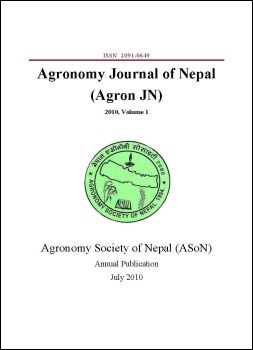Rice (Oryza sativa L) cultivation in the highest elevation of the world
DOI:
https://doi.org/10.3126/ajn.v2i0.7519Keywords:
Jumla region, rice cultivation, cold tolerant variety, highest elevationAbstract
Jumla is one of the 75 districts in the midwestern hills of Nepal. Rice (Oryza sativa L) cultivation in Jumla ranges from 2,400 to 3,050 m altitude, which is the highest elevation in the world. The highest elevation at 3,050 m is Chhumjul of Jumla, a record altitude, where rice is cultivated in Nepal. Jumli Marshi, a Japonica variety of indigenous rice, having cold tolerant gene, is probably cultivated since 1,300 years ago in Jumla in the bank of the Tila river. Improved rice varieties were tested in the Jumla valley by the Nepal Agricultural Research Council (NARC). In 2002, two improved rice varieties Chandannath-1 and Chandannath-3 were released for temperate region of Jumla and Karnali zone. Productivity of rice in Jumla is 1.7 mt/ha almost 40% lower than that of national average of 2.97 t/ha. Low productivity of rice is mainly due to the constraints of many biotic, abiotic and socio-economic factors. Food security in the food deficit region of the Karnali zone could be sustained by increasing rice productivity in the Jumla region where perennial irrigation is available round the year. Whole of the Jumla region is unique place with respect to rice cultivation in the highest altitude of the world. The practice of rice cultivation in Jumla could be a remarkable activity for boosting agro-tourism in the agrarian country like Nepal. Rice cultivation in Jumla is quite unique from the rice cultivation even in the same range of temperate region. Such a typical organic rice production system in the highest elevation of the world needs immediate attention of all institutions and authorities concerned to conserve it for the future generation as well. Jumla, the temperate region, is also affected by the impact of global warming thereby receding water level in the Tila river and its tributaries flowing in the Jumla valleys during rice growing season (March - October). Attempts have been made to document ethno-culture, socio-economic and cultural practices of rice cultivation in the highest elevation in the world.
DOI: http://dx.doi.org/10.3126/ajn.v2i0.7519
Agronomy Journal of Nepal (Agron JN) Vol. 2: 2011 pp.31-41
Downloads
Downloads
Published
How to Cite
Issue
Section
License
ASON permits for free use, distribution and reproduction in any medium if the original work is properly cited and not used for commercial purposes.




